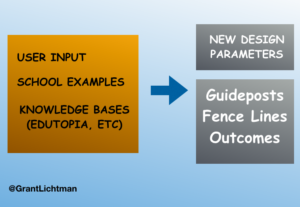Design thinking is an appropriate rage. The routines embedded in DT push us to imagine and design solutions that we otherwise would have likely never encountered. But sometimes we gloss over that key word “design”. I see school teams rush to create solutions before they have a clear set of “design parameters”.
 Lacking clear design parameters there are two pitfalls that lie athwart the path of great solutions. First, we don’t have an agreed upon target of what we are designing for. No good architect designs a building without such a clear understanding and agreement; otherwise we would end up with log cabins in an office park and glass office buildings in the forest.
Lacking clear design parameters there are two pitfalls that lie athwart the path of great solutions. First, we don’t have an agreed upon target of what we are designing for. No good architect designs a building without such a clear understanding and agreement; otherwise we would end up with log cabins in an office park and glass office buildings in the forest.
Second, lacking good design parameters, we can’t have clear measures of success. We may have checked off a box in the strategic plan, but we won’t know if our solution has actually succeeded. I spoke recently to a faculty member of a well-known school that loudly touts their efforts at increasing faculty diversity, yet they don’t have any more faculty of color than they did a decade ago.
Through the design process we gather understanding from our users, from other schools and organizations, and from free knowledge-bases. We use these inputs to craft design parameters. Three potential sets of parameters are these:
- Guideposts: What are some interim targets we can aim for? What are indicators that we are reaching these points or staying on the right path?
- Fence Lines: What are the boundary conditions of our design? How much can we spend? What are the non-negotiables? The things we don’t want to change?
- Outcomes: What will success look like at certain points in the future, and how will we measure it?
As you task teams to design the future, give them this context to support their research into the “possible”. Research is not done for the sake of gaining knowledge; it is used to create a set of parameters that will guide good solution design.












Leave A Comment